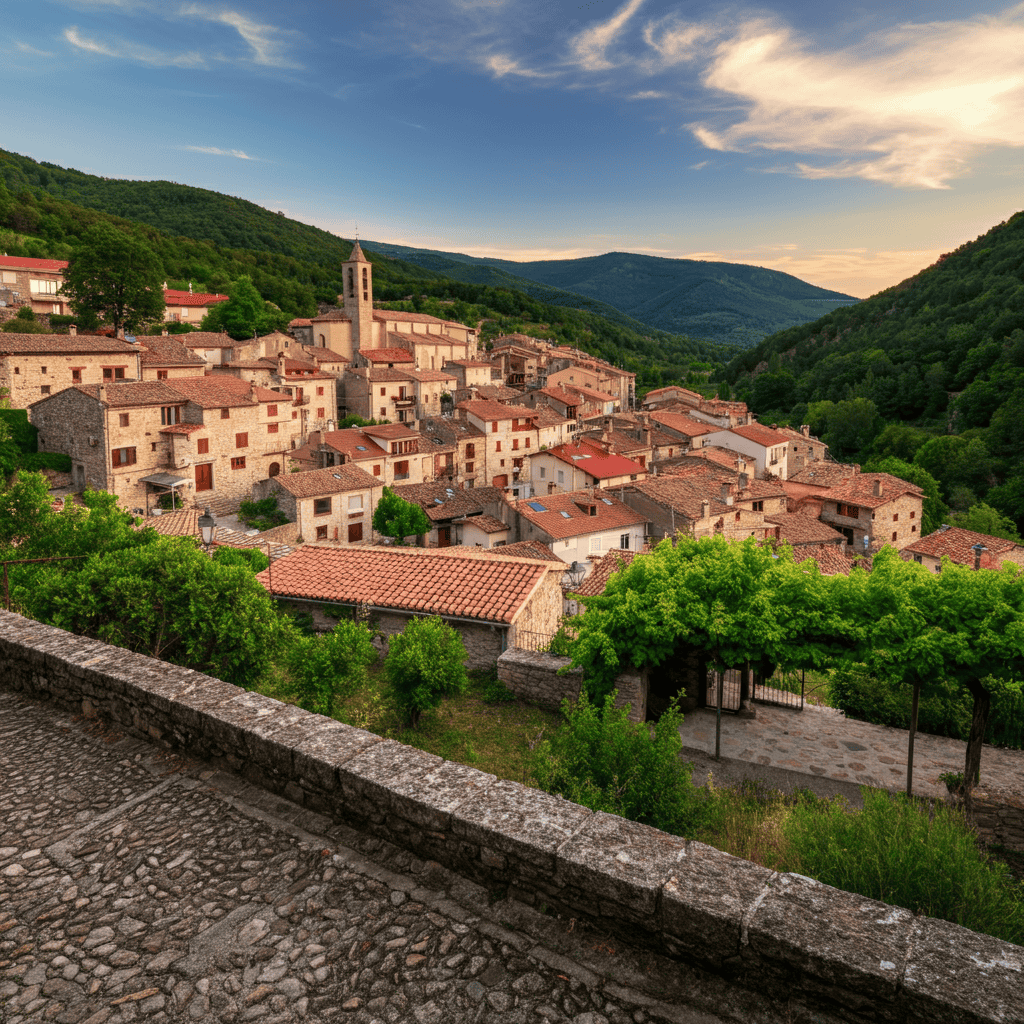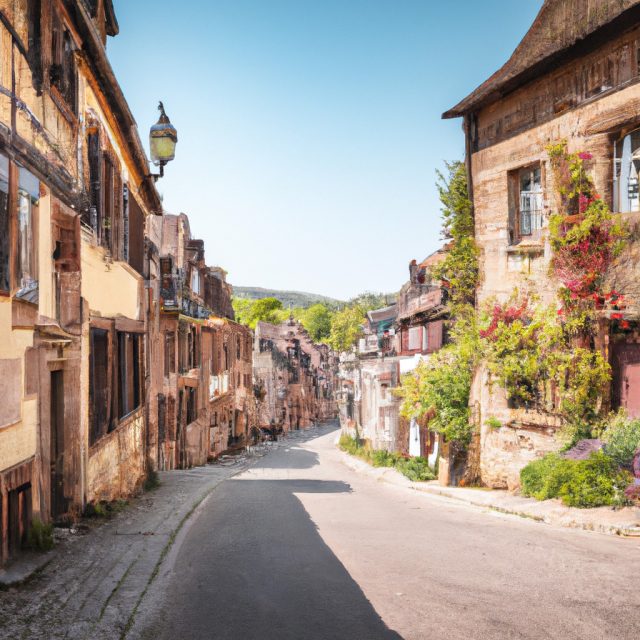Tired of the Crowds? It’s Time to Discover Europe’s Soul
We’ve all seen them: the iconic photos of Europe. The packed crowds at the Trevi Fountain, the endless queue for the Eiffel Tower, and the selfie sticks creating a forest in front of the Colosseum. While these landmarks are magnificent, the experience can often feel more like a theme park than a genuine cultural immersion. The relentless pace, the tourist traps, and the sheer volume of people can leave you feeling drained rather than inspired.
But what if there was another way to experience Europe? A way to step back in time, to connect with a place on a deeper level, and to find the kind of tranquility that postcards only hint at? There is. It lies hidden in plain sight, tucked away in rolling countrysides, perched on dramatic cliffsides, and nestled in forgotten valleys. It’s the world of Europe’s hidden villages.
This guide is your passport to a different kind of travel. We are pulling back the curtain on seven of the most enchanting, relatively undiscovered villages across the continent. These are places where the rhythm of life is slower, the culture is richer, and the memories you make are uniquely your own. Prepare to trade the bustling city symphony for the gentle chime of a village clock tower.
Why Choose the Village Path? The Allure of the Undiscovered
Opting for a lesser-known village over a major capital city isn’t just about avoiding crowds; it’s about embracing a more sustainable and rewarding form of travel. Here’s why you should consider going small on your next European adventure:
- Authentic Immersion: In these villages, tourism hasn’t completely reshaped the local way of life. You’re more likely to stumble upon a generations-old bakery than a chain coffee shop. You’ll witness daily routines, hear the local dialect, and experience a culture that is lived, not just performed.
- Unparalleled Scenery: Many of these villages owe their preservation to their remote locations. This often means they are surrounded by breathtaking natural beauty, from dramatic coastlines and soaring mountains to lush vineyards and pristine forests.
- Support Local Economies: Your travel budget goes directly into the hands of local families and small business owners – the innkeeper, the restaurant owner, the local artisan. This creates a more positive and sustainable impact than spending in oversized, foreign-owned resorts.
- A Slower Pace of Life: Village life invites you to slow down. There are no jam-packed itineraries here. Instead, the joy is found in a leisurely stroll, a long lunch at a piazza cafe, or simply sitting on a bench and watching the world go by. It’s a true vacation for the mind and soul.
Our Selection of 7 Magical Hidden Villages

Get your notepad ready. Here are seven hidden gems that promise an unforgettable European experience, far from the madding crowd.
1. Gásadalur, Faroe Islands: Where Waterfalls Meet the Ocean
For pure, untamed drama, few places can compete with Gásadalur. Tucked away on the island of Vágar in the remote Faroe Islands, this tiny hamlet was, until 2004, only accessible via a strenuous hike over a mountain or by helicopter. Today, a tunnel provides access, but the village retains its profound sense of isolation and otherworldly beauty. Its iconic feature is the Mulafossur waterfall, which cascades directly from the cliffside into the churning North Atlantic Ocean below.
What to See and Do:
The main event is the viewpoint for Mulafossur waterfall – it’s a sight that will be seared into your memory. Take the old hiking path over the mountain for staggering views (for experienced hikers only). Explore the village itself, with its traditional turf-roofed houses and friendly sheep, who vastly outnumber the human residents.
Local Flavors:
Faroese cuisine is hyper-local. Expect to find fermented lamb (ræst kjøt), fresh seafood like cod and salmon, and rhubarb in many local dishes. A small cafe in the village offers simple, heartwarming fare.
Getting There:
Fly into Vágar Airport (FAE). From there, it’s a short drive. Renting a car is the best way to explore the Faroe Islands, and the drive to Gásadalur through the one-lane tunnel is an adventure in itself.
2. Bibury, England: The Quintessential Cotswold Dream
Described by 19th-century artist William Morris as “the most beautiful village in England,” Bibury lives up to the hype. Located in the Cotswolds, an Area of Outstanding Natural Beauty, this village is a time capsule of honey-colored stone cottages, a babbling river, and impossibly green meadows. Its most famous spot is Arlington Row, a collection of 17th-century weavers’ cottages that is one of the most photographed scenes in the country.
What to See and Do:
Stroll along Arlington Row (go early to avoid day-trippers), feed the brown trout at the Bibury Trout Farm, and enjoy a traditional cream tea at one of the charming local tearooms. The Saxon-era St. Mary’s Church is also well worth a visit for its historical significance and peaceful atmosphere.
Local Flavors:
This is the heart of classic British pub country. Find a cozy spot like The Catherine Wheel for a pint of local ale and a hearty plate of fish and chips or a Sunday roast. And, of course, a scone with clotted cream and jam is non-negotiable.
Getting There:
The closest train station is in Kemble (about 20 minutes away by car). However, the best way to experience the Cotswolds is by renting a car, which allows you to explore the winding country lanes and discover other nearby villages like Bourton-on-the-Water and Stow-on-the-Wold.
3. Monschau, Germany: A Half-Timbered Fairytale
While many flock to the more famous towns on Germany’s Romantic Road, Monschau remains a wonderfully preserved secret. Nestled in the narrow, rocky valley of the Rur River in the Eifel region, this village seems untouched by the passage of time. For over 300 years, its slate-roofed, half-timbered houses have remained unchanged, creating a picture-perfect scene that is especially magical during its renowned Christmas market.
What to See and Do:
Wander through the cobblestone streets, admire the Rotes Haus (Red House) museum to see the lavish lifestyle of 18th-century cloth-makers, and hike up to the ruins of Monschau Castle for a panoramic view of the town. A visit to the historic mustard mill, Senfmühle Monschau, is a must for foodies.
Local Flavors:
Sample the local Monschauer Dütchen (a delicate biscuit) and the sharp, flavorful mustard. The region is also known for hearty dishes like sauerbraten and schnitzel, best enjoyed in a traditional Gasthaus.
Getting There:
The nearest major airports are Cologne Bonn (CGN) and Düsseldorf (DUS). From there, it’s easiest to rent a car for the scenic 1.5-hour drive. Public transport is possible but involves multiple train and bus connections.
4. Castelmezzano, Italy: Clinging to the Dolomite Peaks
Forget the Amalfi Coast crowds; for true Italian drama, head south to the Basilicata region. Here you’ll find Castelmezzano, a village that seems to be literally carved into the jagged peaks of the Lucanian Dolomites. Its houses, with their stone-tiled roofs, blend seamlessly into the rockface, creating a spectacular and unforgettable landscape, especially when lit up at night.
What to See and Do:
For adrenaline junkies, the “Volo dell’Angelo” (Flight of the Angel) is a must-do. It’s a high-speed zip line that connects Castelmezzano with the neighboring village of Pietrapertosa, offering bird’s-eye views. For a more grounded experience, explore the steep, winding staircases of the village and hike the “Path of the Seven Stones.”
Local Flavors:
Basilicata’s cuisine is rustic and delicious. Look for dishes with peperoni cruschi (crispy sweet peppers), local cheeses like Pecorino di Filiano, and handmade pasta such as orecchiette. Enjoy a meal at a local trattoria with a view of the mountains.
Getting There:
Fly into Naples (NAP) or Bari (BRI). A rental car is essential for this region, as public transport is limited. The drive itself, through the mountainous interior of Southern Italy, is a stunning part of the experience.
5. Eguisheim, France: The Heart of Alsatian Charm
While Colmar and Strasbourg draw the big crowds in the Alsace wine region, the smaller village of Eguisheim offers an even more concentrated dose of charm. Voted the “Favorite French Village” in 2013, its medieval streets are arranged in concentric circles around a central castle. The narrow lanes are lined with brightly colored, half-timbered houses adorned with overflowing flower boxes, creating a storybook setting.
What to See and Do:
The best thing to do in Eguisheim is simply get lost. Walk the circular ramparts (ramparts), explore the local wineries for a tasting of the region’s famous Riesling and Gewürztraminer wines, and visit the stork park to see the beloved symbol of Alsace up close.
Local Flavors:
Alsatian food is a unique blend of French and German influences. Don’t miss Tarte flambée (a thin, crispy pizza-like dish with cream, onions, and bacon), choucroute garnie (sauerkraut with assorted meats), and the rich Kugelhopf cake.
Getting There:
The village is just a 15-minute drive from Colmar. You can fly into EuroAirport Basel-Mulhouse-Freiburg (BSL/MLH/EAP), which serves all three countries. From Colmar, you can take a taxi, a local bus, or even rent a bicycle to ride through the vineyards to Eguisheim.
6. Telč, Czech Republic: A Renaissance Masterpiece
Prague and Český Krumlov are rightly famous, but for a glimpse of Renaissance perfection on an intimate scale, head to Telč in the Moravia region. The town’s main square (Náměstí Zachariáše z Hradce) is a UNESCO World Heritage site and is simply breathtaking. It’s lined with a long, unbroken row of perfectly preserved Renaissance and Baroque townhouses, each with a unique, pastel-colored facade and ornate gables, all connected by a continuous arcade.
What to See and Do:
The main square is the star attraction. Spend time walking its length and admiring the architecture. Tour the magnificent Telč Château, with its stunning Golden Hall and opulent interiors. You can also walk through the château’s gardens and enjoy the network of ponds that surround the historic town center.
Local Flavors:
Czech cuisine is hearty and satisfying. Try the local carp, a regional specialty, or enjoy classic dishes like svíčková (marinated beef with a cream sauce and dumplings). And, of course, no meal is complete without a glass of excellent and affordable Czech beer.
Getting There:
Telč is located roughly halfway between Prague and Vienna, making it a perfect stop on a Central European road trip. It’s about a 2-hour drive from either city. It can also be reached by a combination of train and bus from major Czech cities like Prague and Brno.
7. Šmartno, Slovenia: A Tuscan Dream in the Alps
Nestled atop a hill in the Goriška Brda wine region, often called the “Tuscany of Slovenia,” Šmartno is a beautifully preserved fortified medieval village. Encased within 17th-century walls, its cluster of stone houses and narrow alleys feels like a journey to another era. The village offers 360-degree views of rolling hills covered in vineyards, olive groves, and fruit orchards, stretching all the way to the Julian Alps.
What to See and Do:
Walk the defensive walls, climb the bell tower of St. Martin’s Church for the best views, and explore the small art galleries and craft shops. The main activity, however, is wine tasting. The Brda region is famous for its Rebula white wine, and many family-run cellars (klets) in and around the village welcome visitors.
Local Flavors:
The cuisine is a delightful mix of Slavic, Germanic, and Italian influences. Enjoy homemade prosciutto, local cheeses, and seasonal dishes made with wild asparagus or cherries. Many wineries offer food pairings that showcase the best of the region’s produce.
Getting There:
The nearest airports are Trieste, Italy (TRS) and Ljubljana, Slovenia (LJU). A car is highly recommended to explore the wine region at your own pace. Šmartno is about a 1.5-hour drive from Ljubljana.
Your Journey Awaits
Choosing to visit one of these hidden villages is more than just a vacation; it’s an investment in a more mindful and meaningful way of travel. It’s about trading the checklist for connection, the crowds for community, and the fleeting snapshot for a lasting memory.
This list is just a starting point. Europe is filled with countless other hamlets and towns waiting to be discovered. So, on your next trip, dare to take the road less traveled. Turn off the main highway, follow that small, winding lane, and you might just find your own magical, hidden village. The soul of Europe is waiting for you there.
Learn more: Ultimate Trip Planning Guide














